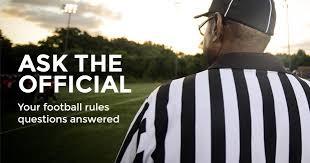Ask the Official: Punters don’t have to take a direct snap to be protected from roughing

USA Football Rules Editor Bill LeMonnier is a former college referee who currently serves as an ESPN NCAA rules analyst. Click here to ask Bill a question. Make sure to put “Ask the Official” in the subject line.
***
During a recent youth football game being played with high school rules, it was raining hard, and one team was having troubles snapping the ball back to its punter. So what they did was a direct snap to the quarterback, who then pitched the ball eight to 10 yards back to the punter, who then kicked it.
In the fourth quarter after doing this three or four times, a defensive player hit the punter from the side as the kick was away. The referee standing behind the punter flagged it immediately for roughing the kicker, but the defensive coach argued that the punter gives up his right to protection by taking the ball via a pitch and at that point is a running back.
Who is right?
I’ve never heard of a rule where a player “gives up his rights” because the ball was pitched to him. Once a player is established as a punter in the youth and NFHS rules and as long as it’s obvious a scrimmage kick can be made, that player receives all of the protections as a punter. In the NCAA, if the punter leaves the tackle box to punt the ball – say, rugby style – does give up his protection for potential roughing the kicker.
It’s the same way for running backs and wide receivers who take a pitch or a lateral then set up to throw downfield. The NFHS rule book never uses the terms “quarterback” or “punter.” It refers to “passer” and “kicker.” So just because someone lines up at a spot other than quarterback, he can still become the “passer” on the play.
Now, the defense is off the hook if contact is unavoidable because it is not reasonably certain a kick will be made, say the passer or kicker is running laterally. But that’s a judgement call by the official.
***
With as many fast-paced offenses as there are in high school, college and pro football, is there any rule against having two sets of chain crews so one can stay downfield and set up on a long play instead of the players having to wait on the sticks to get set up?
On a new first down and no offensive substitutions, the ball can be made ready for play relatively quickly as long as the down marker box – the one with the numbers on it – gets set. Officials don’t have to wait for the chains. It’s rare that it takes more than eight to 10 seconds to get the ball, spot it and have all of the officials in position to go. Also, the game clock is stopped for a new first down at youth, high school and college levels, so we’re not really in a hurry up situation, though officials should still move quickly if the offense wants to run at a fast pace.
As for a second set of chains, it’s not happening. It’s just not practical as congested as it is on the sideline already. And by adding another set of chains, you are just asking for confusion and lost time over crews bumping into each other or not being read. Two chain crews is just overkill.
